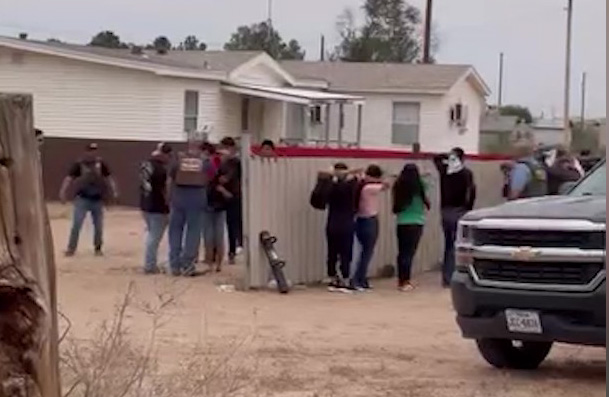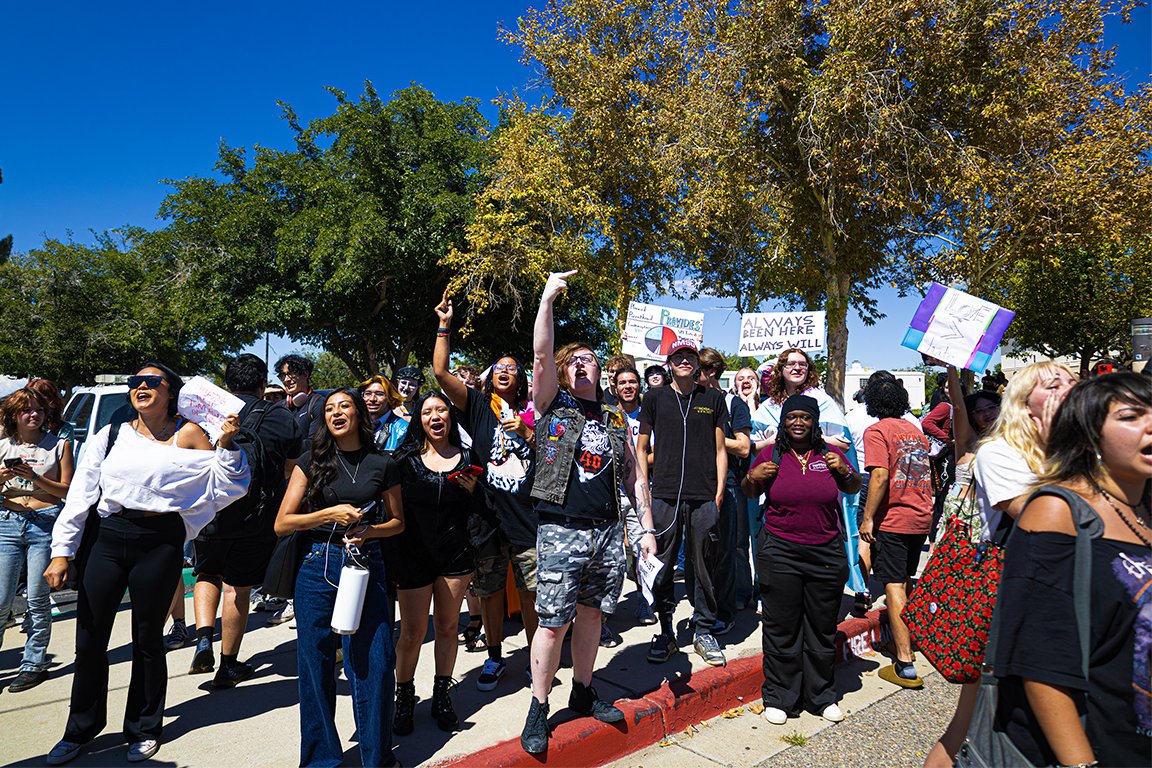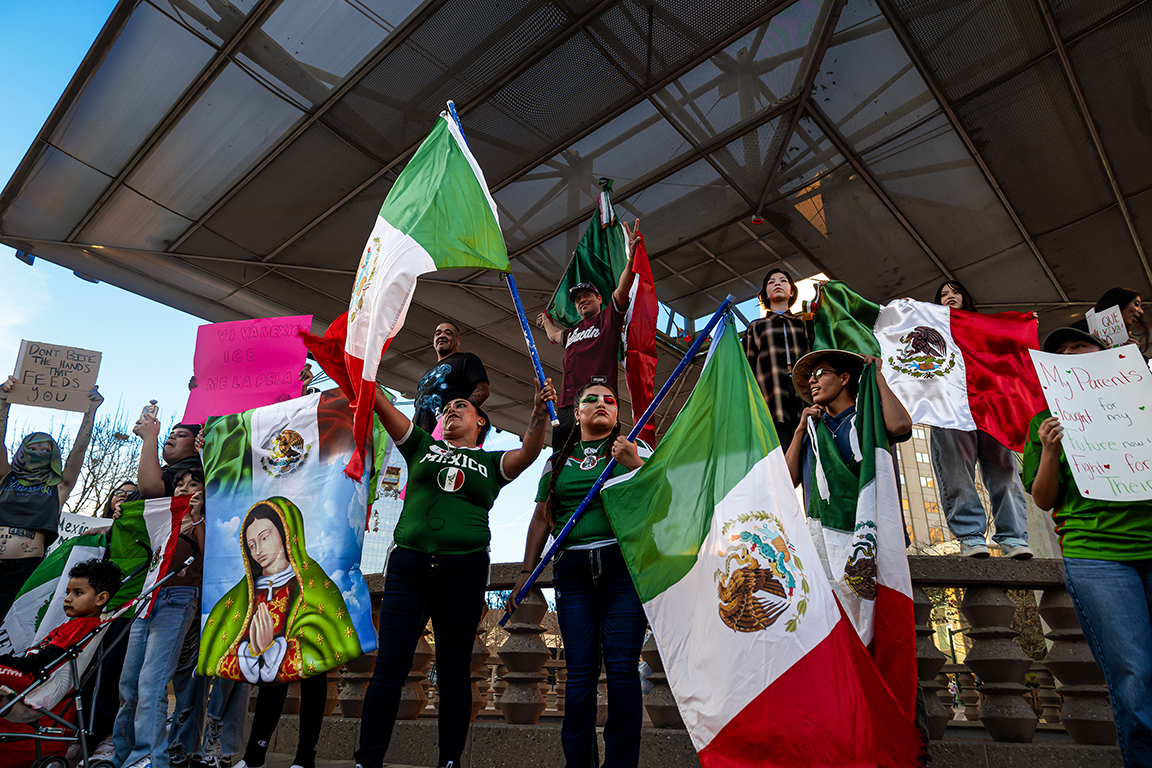On Sept. 7, Secretary of Homeland Security Kristy Noem reported that 35 people were arrested Thursday, Sept. 4 in connection with an alleged smuggling scheme.
According to her post on X, two Mexican nationals were arrested after a car rolled over in El Paso trying to evade Border Patrol agents. The follow-up operation led to 28 arrests in Chaparral. The total arrests are now 35: 25 remain in Immigration and Customs Enforcement (ICE) custody, eight were charged with alleged illegal re-entry and transferred to the United States Marshal Service (USMS), and two alleged smugglers face federal prosecution.
“This is law and order in action. Human smugglers take note: do not attempt these reckless schemes. We will find you, we will prosecute you, and you will face the full weight of justice,” Noem said.
On Sept. 4, community members and organizers gathered at the scene of the raid. They recorded instances of alleged brutality by federal agents, aggression towards bystanders, and the agents’ refusal to identify themselves.
Maty Gonzalez, a community organizer at NM CAFe, said she received a phone call at 1:29 p.m. reporting 15 ICE vehicles were outside a house in Chaparral, NM. While Gonzalez was on her way there, agents began to park vehicles in front of and behind the property, Gonzalez said.
Jovanny Sebastian Hernandez, campaigns manager for NM Dream Team, claimed the federal agents who were present included members of ICE, Department of Homeland Security (DHS), U.S. Border Patrol, and Border Patrol Tactical Unit (BORTAC).
From a video a community member shared with The Round Up, some of the agents wore plain clothes while others wore military-style uniforms. The video also shows a tactical vehicle and unmarked vans and trucks.
The weapons included heavy-duty rifles, non-lethal crowd control weapons, plastic explosives, and flash bangs, according to Hernandez.
As more community members arrived, Hernandez said agents began taking pictures and videos of community members’ license plates and the insides of their vehicles as “Some kind of intimidation tactic.” Hernandez also said a federal agent threatened “To take me down if I wasn’t five feet away from him.”
Hernandez also said the agents refused to identify themselves to bystanders.
“Myself and others asked multiple times to multiple people who were there, the agents, to identify themselves and what agency they worked for, and they never did,” Hernandez said.
Gonzalez said the federal agents didn’t have a search warrant when they arrived. Two vehicles left to get one, which Gonzalez said took several hours. Gonzalez said two warrants were issued due to the first containing an incorrect address.
Community member and eyewitness, Lucas Herndon, said around 5:30 p.m. federal agents moved a tactical vehicle closer to the residence. Upon dismounting the vehicle, the agents allegedly laid a door-breaching explosive on the glass front door, Herndon said. The agents allegedly used a bull horn and sirens to threaten to blow the door if no one came out, Herndon said.
Following the threats, Herndon said, a group of young men left the residence. The tactical team allegedly threw a flash bang into the house through the door, entered the house, and escorted the rest of the residents out. The plastic explosive was later removed from the door and never went off.
Herndon said one of the girls who came out of the house didn’t have shoes on. He also said he overheard a Border Patrol agent allegedly say a seven-year-old girl was hit by the flash bang.
“Ultimately, they used violence against children, and that’s unacceptable,” Herndon said. “. . .The scope of what I saw was armed, militarized agents of the government assaulting a house full of unarmed individuals.”
Volunteer and community member Angel Amabisco sent The Round Up a video showing federal agents in police vests and a line of people with their hands behind their heads and backs.
Herndon said most of the people were loaded into two vans, and at least two were separated from the others and put in a Border Patrol vehicle. He said the federal agents removed the detainees’ personal belongings and put them in plastic bags.
Gonzalez said the 28 people detained at the house mostly looked like they were from Latin America and South America. Between six to eight were youth, Gonzalez said.
Throughout the raid, Gonzalez said she educated the detainees on their rights not to sign documents they can’t read or are being forced to sign and told them to write phone numbers on their arms.
According to Hernandez, the Doña Ana County Sheriff’s office was present at the scene but left after speaking with the federal agents.
District Representative Sarah Silva said community members contacted her to let her know about the ICE presence. She then reached out to congressman Gabe Vasquez, who sent Doña Ana County Sheriff deputies to confirm the agents were legitimate law enforcement officers. Silva also said she knew the agents were looking for someone with charges “related to trafficking people.”
“I do not want individuals or cartels trafficking people or drugs in our communities and want this activity to stop,” Silva said. “When ICE agents and Border Patrol agents show up in our neighborhoods masked, unwilling to identify themselves, and take people without explanation in unmarked vehicles this creates distrust and fear, the opposite of public safety that people in Chaparral deserve.”
Anita Skipper, Communications Coordinator for the Public Information Office of Doña Ana County, also said the incident was a response to a reported human trafficking.
“According to Sheriff [Kim] Stewart, the raid was not an ICE raid,” Skipper said. “It was a Border Patrol action on a reported stash house for trafficked humans. She received calls on this from the public timely with the event and confirmed this information.”
Gonzalez confirmed the house was being used to house undocumented immigrants. She said she has a video of the house, showing ID cards from various countries.
Hernandez said he sees this as part of a larger problem with the federal government’s immigration policy. He called on federal and local governments to be held accountable for creating “An immigration system that denies people the right and the ability to move, the freedom to transform their lives, to create what they want in a country where they want to live.”
“I don’t think it’s right that people are human traffickers. I think that’s wrong,” Hernandez said. “And I think the reason that it’s so profitable, that business is so profitable by the cartels and by independent folks who do that kind of stuff, is because of the United States, is because of the immigration system they create that incentivizes folks.”
This is a developing story. The Round Up will provide updates as they become available.








